Physical Address
304 North Cardinal St.
Dorchester Center, MA 02124
The mononuclear phagocyte system includes monocytes, macrophages/histiocytes, and dendritic cells. Macrophages/histiocytes are tissue-based cells that have an important phagocytic function and produce a variety of bioactive substances that play roles in inflammation and fibrosis. Alveolar macrophages are a normal constituent cell population in the lungs, and pulmonary histiocytic accumulations are not an uncommon finding in this location, occurring in some infections, pneumoconioses, sarcoidosis, storage diseases, lipid pneumonia, respiratory bronchiolitis, alveolar hemorrhage, drug reactions, and crystal-storing histiocytosis, disorders that are discussed elsewhere in this book. Dendritic cells present antigens to T-lymphocytes and are normally scattered throughout the airways. The most important dendritic cell proliferation involving the lung is pulmonary Langerhans cell histiocytosis (PLCH), a disease that is highly associated with tobacco smoking and occurs primarily in adults. PLCH is a Langerhans cell proliferation that appears to be reactive in its origin, though interesting recent work has uncovered evidence suggesting clonality in at least a portion of cases. The systemic form of Langerhans cell histiocytosis that is more common in children is a clonal, neoplastic process. Another extremely rare group of histiocytic and dendritic cell lesions arising in the lung is that of primary pulmonary histiocytic and dendritic cell neoplasms. This category includes histiocytic sarcoma, Langerhans cell sarcoma, interdigitating dendritic cell sarcoma, and follicular dendritic cell sarcoma. Finally, Rosai-Dorfman disease (RDD) and Erdheim-Chester disease (ECD) are other disorders of related origins, which can involve the lung and will be discussed in this chapter.
A dendritic cell disorder that presents as an interstitial lung disease primarily in smokers
Uncommon process, accounting for less than 7% of interstitial lung diseases
Most patients are between ages 20 and 40, but a wide age range (1–69 years of age) has been reported
No clear gender predominance
Caucasians are primarily affected
Symptoms include dyspnea, cough, and chest pain, and constitutional symptoms (fever, weight loss, and night sweats) or hemoptysis can also occur
Pneumothorax is the initial clinical presentation in 10%–15% of patients
Up to 25% of patients are asymptomatic
Pulmonary function testing commonly shows normal or obstructive patterns and a restrictive pattern may be seen in later fibrotic stages; reduced diffusing capacity for carbon monoxide is common
With advanced disease, clubbing and manifestations of cor pulmonale may develop
Chest radiograph
Ill-defined nodules and curvilinear or reticular opacities are most conspicuous in the midlung zones and upper lobes
Over time, cystic changes tend to increase
Chest computed tomographic scans
Cysts are seen in 80% and nodules in 60%–80% of patients, with upper and midzone predominance
Early cases show a centrilobular distribution of nodules, and cystic changes become more prominent with time
Clinical and radiographic stabilization occurs in up to 50% of patients, spontaneous regression in up to 25%, and progression to respiratory failure in the remaining patients
Pulmonary hypertension is a common problem that can limit exercise tolerance
Lung cancer, lymphoma, and myeloproliferative disorders have been reported to occur with increased frequency in patients with PLCH
Cessation of smoking is recommended
Some studies have found a benefit to treatment with corticosteroids, and chemotherapeutic agents have also been used for individual patients with rapidly progressive disease
Lung transplantation has also been performed for advanced disease, but PLCH has recurred after transplantation
Well-demarcated, tan-white, airway-centered nodules usually less than 1 cm in diameter, often with stellate shape, particularly in the upper and middle lobes, with adjacent cysts
Bronchiolocentric nodules and cysts are scattered throughout the parenchyma, often accompanied by peripheral accumulations of smokers’ macrophages
Younger lesions are more cellular than older lesions and include clusters of Langerhans cells mixed with variable numbers of eosinophils, lymphocytes, plasma cells, neutrophils, and macrophages
Langerhans cells are round or oval cells with eosinophilic cytoplasm and folded or indented nuclei that may demonstrate grooves
As the lesions age, the Langerhans cells and other inflammatory cell populations decline and the lesions become more fibrotic, eventually evolving into stellate scars, often with radial extensions, or “tentacles”
Airspaces adjacent to the fibrotic areas become cystically enlarged secondary to traction
Langerhans cells express CD1a, S-100, langerin (CD207), HLA-DR, and CD4, and staining for CD45, CD68, and lysozyme is variable
Results for CD antigens associated with B-cell and T-cell differentiation are negative, as are results for CD21, CD30, CD34, CD35, and myeloperoxidase
Birbeck granules in the cytoplasm of Langerhans cells
DIP (can also coexist with PLCH)
EP
UIP (with advanced fibrotic cases)
Airspace enlargement with fibrosis (with advanced fibrotic cases)
Histiocytic and dendritic cell neoplasms
Hodgkin lymphoma
In 1951, the first cases of primary PLCH were described, and numerous cases have been reported since then using nomenclature, including PLCH, histiocytosis X, eosinophilic granuloma, and Langerhans cell granulomatosis. PLCH is an uncommon disorder, accounting for less than 7% of interstitial lung diseases. It is considered to be a reactive process secondary to an immune dysregulation caused by the constituents of inhaled smoke. Recruitment of Langerhans cells to the lungs in PLCH may be driven by cigarette smoke–induced increases in tumor necrosis factor alpha (TNFα) and granulocyte macrophage colony–stimulating factor, reduced interleukin 2 (IL-2) production, and bombesin-like peptide secretion by neuroendocrine cells. However, only a small percentage of smokers develop PLCH. Genetic studies have recently shown the presence of BRAF V600E mutations in some patients with PLCH and suggest that the disease may represent a clonal proliferation of Langerhans cells. Interestingly, ECD and RDD can each coexist with Langerhans cell histiocytosis in small numbers of patients.
Most patients present with symptoms between ages 20 and 40, but a wide age range (1–69 years of age) has been reported. PLCH is rare in children and, when present, is usually associated with multisystem disease, which is a clonal neoplastic process. Individual studies have reported both male and female gender predominance. Caucasians are primarily affected, and the disease is uncommon in individuals of African or Asian descent. More than 90% of patients with PLCH are smokers versus 44% of patients with non-PLCH. Symptoms include dyspnea, cough, and chest pain; constitutional symptoms (fever, weight loss, and night sweats) or hemoptysis can also occur. In approximately 10% to 15% of patients, pneumothorax-associated chest pain is the initial clinical presentation of the disease. Up to 25% of patients, however, are asymptomatic. Pulmonary function testing more commonly shows normal or obstructive patterns; a restrictive pattern may be seen in later fibrotic stages. Reduced diffusing capacity for carbon monoxide is common. With advanced disease, clubbing and symptoms and signs of cor pulmonale may develop. Associated extrapulmonary manifestations can include diabetes insipidus due to pituitary involvement, bone lesions, and skin involvement by PLCH.
The most common chest radiographic abnormalities include ill-defined nodules and curvilinear or reticular opacities. Involvement is usually most conspicuous in the midlung zones and upper lobes and tends to be symmetric. Over time, cystic changes tend to increase. Computed tomographic (CT) scans of the chest show cysts in 80% and nodules in 60% to 80% of patients, with upper and midzone predominance. Early cases show a centrilobular distribution of nodules, and cystic changes become more prominent with time. In an adult smoker, the combination of these nodules and cysts is highly suggestive of PLCH.
Well-demarcated, tan-white, airway-centered nodules, often with stellate shape, usually measuring less than 1 cm in diameter, are found particularly in the upper and middle lobes, with adjacent cystically enlarged airspaces.
In PLCH, bronchiolocentric nodules ( Fig. 23.1 ) are scattered throughout the parenchyma, often accompanied by peripheral accumulations of smokers’ macrophages. Younger lesions tend to be more cellular than older lesions and include clusters of Langerhans cells mixed with variable numbers of eosinophils, lymphocytes, plasma cells, neutrophils, and macrophages ( Fig. 23.2 ). Langerhans cells are round or oval cells with eosinophilic cytoplasm and folded or indented nuclei that may demonstrate grooves. As the lesions age, the Langerhans cells and other inflammatory cell populations decline, and the lesions become more fibrotic, eventually evolving into stellate scars, often with radial extensions or “tentacles” ( Figs. 23.3 and 23.4 ). Airspaces adjacent to these fibrotic areas become cystically enlarged ( Fig. 23.4 ). Definitive diagnosis usually requires wedge biopsy.
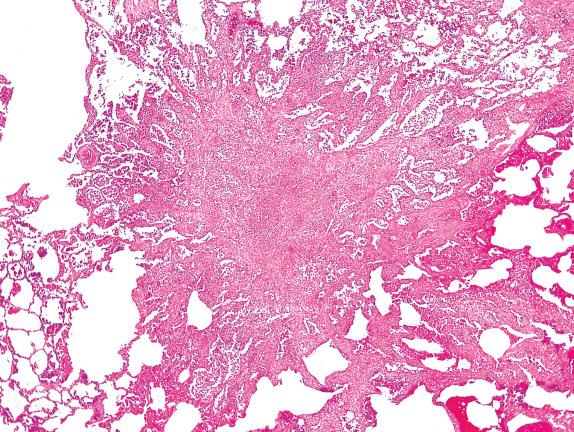
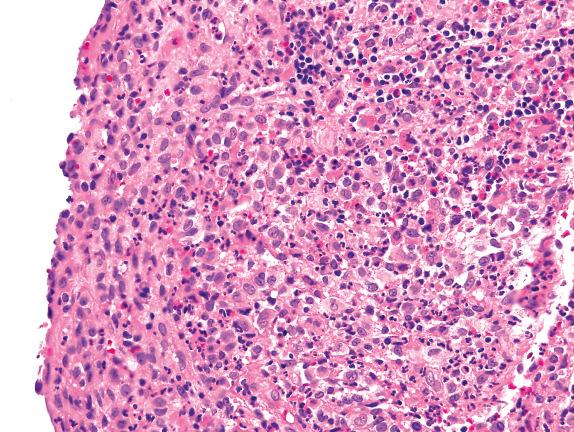
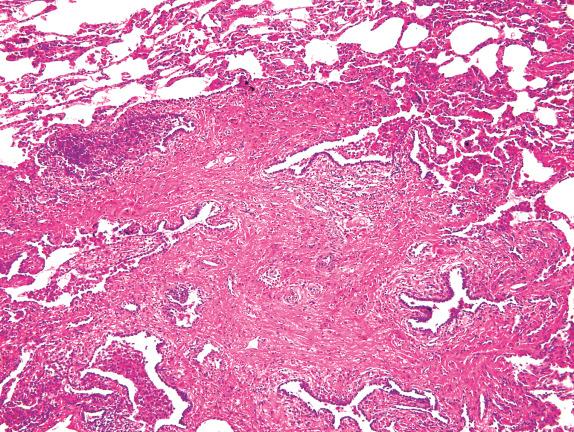
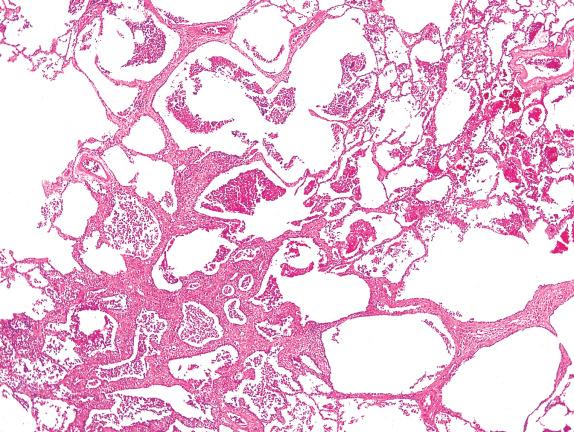
Bronchoalveolar lavage fluid demonstrates more than 5% CD1a+ Langerhans cells in many patients.
Langerhans cells express CD1a ( Fig. 23.5 ), S-100, langerin (CD207), HLA-DR, and CD4. These cells are more commonly present in the earlier active stage of disease, but may not be detected in biopsy tissue once fibrosis is established. In practice, CD1a staining is particularly valuable for highlighting the diagnostic clusters of Langerhans cells in surgical pathology specimens, and the presence of greater than 5% CD1a-positive cells in bronchoalveolar lavage specimens has been suggested to correlate with a diagnosis of PLCH. Staining for CD45, CD68, and lysozyme is variable. Staining for CD antigens associated with B-cell and T-cell differentiation is negative, as is staining for CD21, CD30, CD34, CD35, and myeloperoxidase.
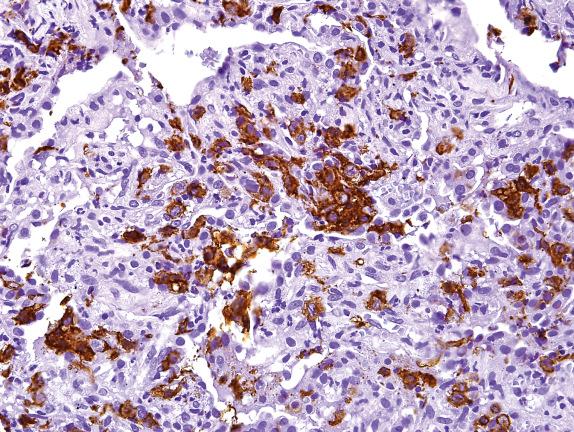
Electron microscopy has been supplanted by immunohistochemistry as a diagnostic tool for PLCH but can be useful for showing Birbeck granules in the cytoplasm of Langerhans cells.
The histologic differential diagnosis includes desquamative interstitial pneumonia (DIP), eosinophilic pneumonia (EP), usual interstitial pneumonia (UIP), histiocytic and dendritic cell neoplasms, and Hodgkin lymphoma. Identification of clusters of Langerhans cells with characteristic morphology and immunohistochemical staining reactivities should exclude these other processes; the bronchiolocentric nature of the process, cystic airspace enlargement, and accompanying mixed inflammatory infiltrates are also important for recognizing PLCH. DIP is a diffuse process, rather than a nodular process with intervening, unaffected parenchyma. The spectrum of cell types seen in PLCH is lacking in DIP, which consists predominantly of infiltrates of macrophages. EP demonstrates large numbers of eosinophils in airspaces, accompanied by variable numbers of macrophages but not clusters of Langerhans cells. An advanced, fibrotic case of PLCH can resemble UIP, but UIP affects the lower lobes more than the upper lobes and preferentially the subpleural areas rather than the centrilobular areas affected in PLCH. The stellate shape of the nodules is another clue to the diagnosis of PLCH rather than UIP. Airspace enlargement with fibrosis shares the presence of dense hyalinized alveolar septa adjacent to enlarged airspaces with advanced PLCH but lacks the cellular lesions of PLCH, the peribronchiolar distribution, and the stellate lesional shape. However, these two processes can coexist, because they are linked to the common predisposing factor of tobacco smoking. Histiocytic and dendritic cell neoplasms of the lung are very rare, and tumor cells usually demonstrate malignant nuclear features. Hodgkin lymphoma manifests a mixture of inflammatory cells but also includes Reed-Sternberg cells and Reed-Sternberg variants that are positive for CD30, CD15 and PAX5, unlike PLCH.
Become a Clinical Tree membership for Full access and enjoy Unlimited articles
If you are a member. Log in here